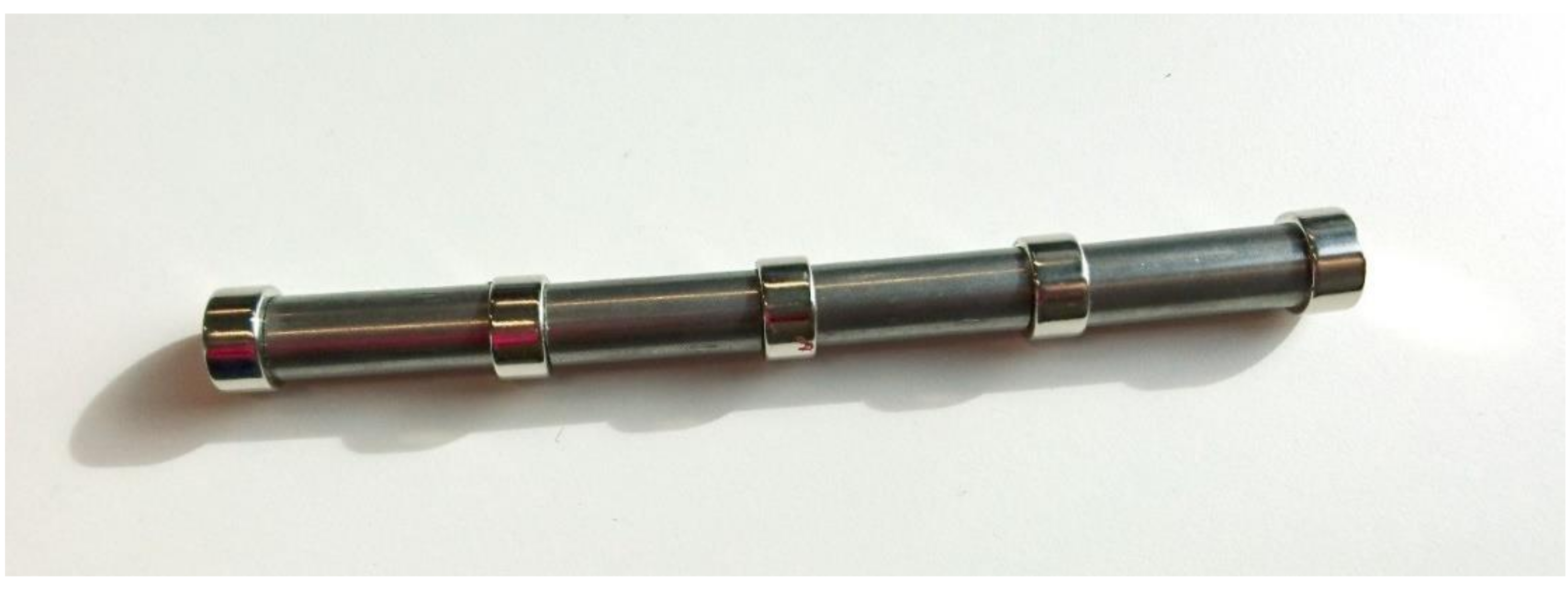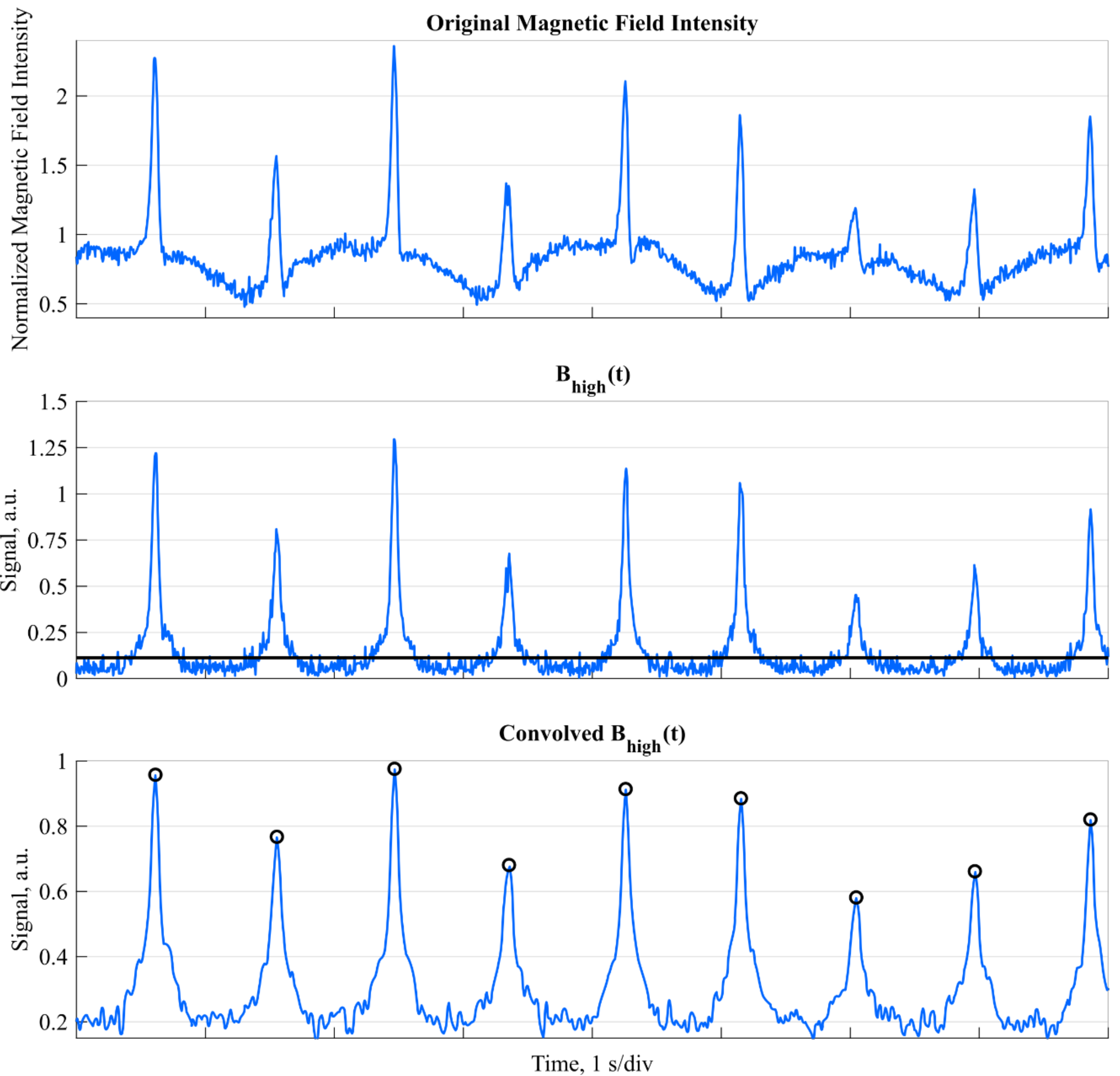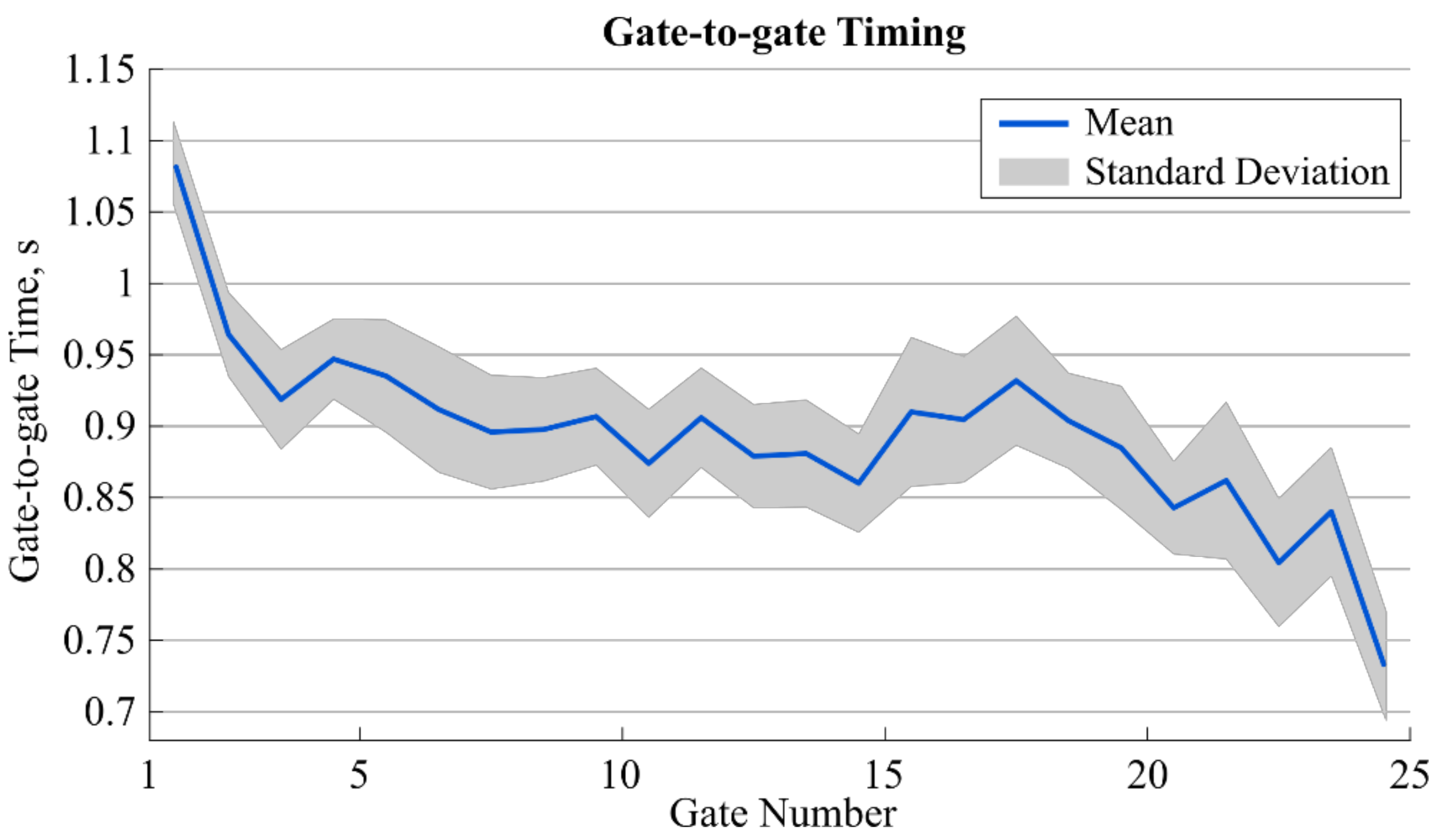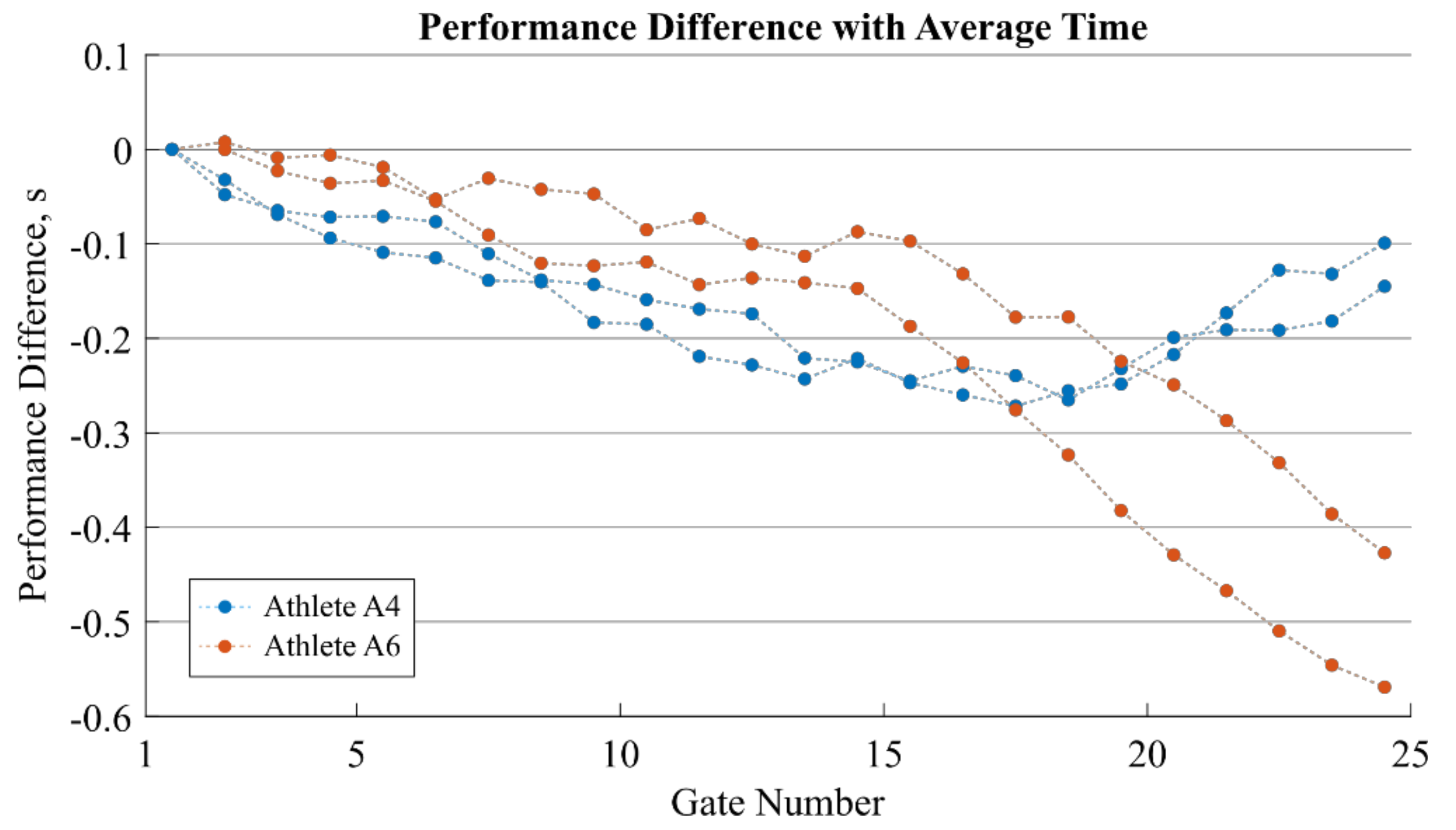1. Introduction
In alpine ski racing, performance is defined as the total time elapsed between the start and finish [
1]. For increasing spectator attractiveness (competition setting) and to provide performance-related feedback (training setting), intermediate times are also commonly used. Traditionally, total race time and intermediate times are measured with photocells [
1].
Despite being technically possible, for practical reasons, the number of photocells in a competition along a race course is usually limited to three–four. Furthermore, in slalom and giant slalom world cup races, intermediate times are usually hand triggered due to too much team staff traffic on the slope and therefore potentially containing human mistakes (personal communication with FIS (Fédération Internationale de Ski) race directors). In a training setting, wireless photocells cannot be placed arbitrarily far away since radio connection between each photocell is required for the transmission of the intermediate times to the start or finish. However, especially for performance-related feedbacks during competition and/or regular training sessions, it would be desirable to have a higher amount of intermediate times and no limitations in terms of spacing between photocells.
Race time differences between athletes have been shown to be in the order of 1%–3% of total race time [
2,
3], with individual section time (i.e., time between two intermediate times spaced at least one gate apart) differences reaching up to 10% [
3,
4]. It is generally believed that these differences arise from the different technical abilities of the skiers and their tactical choices while skiing down the race course [
3]. While section times may be considered inappropriate for understanding the underlying mechanism of an athlete’s overall performance [
5], they might still be important to rapidly and intuitively identify strengths and weaknesses of an athlete throughout different course sections. While the different performance parameters (e.g., instantaneous performance and energy loss) proposed, and largely discussed in previous studies [
2,
5,
6,
7,
8], might explain the overall performance outcome from a scientific point of view, these concepts are difficult to translate into a “coaching language”. From a practical point of view, for example, it might therefore be more appropriate to point out to an athlete that his time for a particular section is 10% worse compared to his peers.
The ability to routinely measure multiple section times or even gate-to-gate times might therefore open up new perspectives for improving performance feedback within a training session and consequently the training quality of an athlete. Gate-to-gate times would also allow for the better quantifying of the effect of different tactical choices, e.g., the strategy of minimizing gate-to-gate times at every single gate versus minimizing the gate-to-gate times at specific gates at the cost of longer gate-to-gate times at the other gates.
Especially for the technical disciplines such as slalom and giant slalom, the ski racers are passing the gates closely (approximately at distances of less than 1 m). Thus, recording the time of each gate crossing could replace the intermediate times and allow a more detailed performance feedback to the ski racers. Such a system was first described by Lachapelle et al. in 2010 [
9], however, without providing any details on how timing information was obtained or validated. In 2011, Supej and Holmberg [
10] published a validation study for a system to measure gate-to-gate times. In that work, skiing trajectory was measured with a differential global navigation satellite system (GNSS) fixed to the ski racers and by surveying all gate positions. Gate crossing time was then defined as the instant of time the athlete crosses a plane perpendicular to the skiing line and aligned with the gate’s position. They reported an intermediate time difference to a photocell-based system of 0 ± 3 ms (mean ± standard deviation). A similar GNSS-based approach was also suggested for sprint running [
11]. Intermediate time errors over sections of 20 m of 2 ± 5 ms (mean ± standard deviation) were reported. However, in these studies, athletes were required to wear additional equipment in a small backpack or belt pocket, a GNSS reference base station was needed, and for the skiing study, an exact surveying of the gate positions had to be performed. Thus, such methods are limited regarding their practicability for use during competitions and/or daily trainings.
In contrast, magnetometers might offer a simpler approach for measuring gate crossing and intermediate times. From physical laws it is known that the magnetic field potential of a magnetic dipole is decreasing with the third power of the distance to the source [
12]. If the dipole’s intensity is known, a magnetometer could be used to estimate its distance to the dipole’s centre based on the measured magnetic field. If the magnetometer is moving in space, it should be able to detect the presence of a magnetic dipole, given that it moves temporarily within a range where the magnetic field is sufficiently large to be measurable. Further, the measured magnetic field would be largest when the magnetometer is closest to the magnetic dipole. Thus, the assumptions for this study were: (1) That a magnetometer fixed to an alpine ski racer could detect the presence of magnets placed along the slope and (2) that the measured magnetic field would be at the maximum when the ski racer comes closest to the magnet. If the magnets would be placed at the gates, then the time of the gate passage could be measured. A proof-of-concept of such a system has been presented at a conference [
13], however, without providing the algorithm implementation details and with a sensor fixed on the thigh, causing a turn-dependent detection bias.
Therefore, the main aim of this study was to improve the design of Reference [
13] and to validate this simple-to-use magnet-based timing system to detect gate crossings in alpine ski racing. The secondary aim was to illustrate the potential for performance analysis that the presented system could offer by visual analysis of each athlete’s gate-to-gate time performance differences with respect to the group’s average gate-to-gate times.
4. Discussion
In this study, a system was designed and validated to automatically detect gate crossings in alpine ski racing. Magnets were placed at each gate and a magnetometer fixed to the ski racers’ lower back recorded the distortions created by these magnets. We proposed a peak detection algorithm besides an inertial sensor based magnetic field correction to reach high enough precision and accuracy to show the usefulness of the method for performance evaluation.
We reached 95% error intervals for gate-to-gate and section times below 0.025 s with respect to the reference system (
Table 1). This is higher than the current alternative where a 95% error interval below 0.01 s was reached based on the skiing trajectory and a complex differential GNSS setup [
10]. The higher error of our system might be explained by the relatively low sampling rate of only 166.7 Hz, limiting the time resolution of our system to 0.006 s (corresponding to a distance travelled of 0.084 m when skiing at 14 m/s), whereas Reference [
10] used a spline interpolation to obtain a position measurement at every 0.001 m. Thus, by increasing the magnetometer’s sampling frequency, the system’s errors might be further reduced.
However, compared to the GNSS-based approach, the proposed system’s setup is easier to use since it does not need a differential GNSS with a base-station and a surveying of each gate’s position. Except for the magnets, no other extra hardware is required to be placed on the ski slope. Meaningful performance-related time differences within short sections have been reported to be in the range of 0.02 s and more [
2,
3,
4,
5,
16,
17]. Therefore, our system might be limited in reliably detecting time differences for very subtle performance changes. On the other hand, the proposed system is easy to use and proved to have an even lower setup time than photocells. Therefore, although maybe slightly less precise than photocells, such a system could find a broad acceptance among coaches for a regular use during daily trainings. To increase practical use in a training environment, collected data could be automatically downloaded over Bluetooth after each run and processed within a smartphone app. For real-time applications in a race environment, the collected data could be processed on the sensor and results wirelessly transmitted to base stations installed along the ski slope.
Another advantage of the proposed system was that timing information could be obtained for every single gate of the course, allowing a much more in-depth performance analysis for each athlete compared to a photocell-based time measurement system.
Figure 5 illustrates well the information gain of the gate-to-gate timing. Both athletes were better than the average, however, in different ways. Ignoring a performance difference at the start, the athletes had a similar performance increase during the first two thirds of the race. However, for the last third, A6 gained in both of his runs significantly more time, while A4 was losing time. A traditional timing system with only one or two intermediate times over the 25 gates would not have been able to measure this difference in performance. For the practitioner, such an analysis might thus provide essential information about how the technical skills and tactical choices of each athlete influence the performance.
4.1. Potential System Limitations
At first glance, a potential limitation of the proposed magnet-based timing system might be the fact that the detectable distance between the magnetometer and gate is given by the magnet’s specifications. The current setup allowed a maximum distance of approximately 1 m. Thus, it can only be used for the detection of gates at which the ski racers are passing closely. As a consequence, in the current study, not all gate crossings for the first and last gates could be detected. While in slalom and giant slalom skiing the athletes usually cross each gate closely, in super-G or downhill skiing the current setup might not work in all race situations. However, in such cases, multiple magnets could be buried under the snow surface along a perpendicular line that crosses the skiing line. Such a setup could also be used for marking the start and finish lines. Another potential limitation of the proposed timing system might be related to the fact that time during which a distortion is measured decreases for increased speed. Consequently, the peak-width is also decreased. However, the sampling frequency and peak detection algorithms were designed to work for speeds of up to 140 km/h allowing for measurement of the gate crossings for all skiing disciplines. Similar to what is already reported in Reference [
10], it is expected that timing precision will increase for higher speeds, mostly due to the reduced peak-width, and thus, decreased uncertainty in the estimated peak location.
4.2. Limitation of the Study
A limitation of the present study was the small sample size of only eight athletes. However, 100% of the gates (excluding the first and last gates) were detected correctly and no outliers were observed, confirming the validity of the results. Nevertheless, for future applications in competitions, we advise the use of a traditional photocell-based system in parallel to allow a critical comparison with the proposed system.
Finally, it has to be pointed out that a major advantage compared to traditional photocell-based timing systems is that the proposed magnet-based system is not limited by the number of intermediate times and cannot have any wrong triggering caused by other team staff on and around the track. Thus, with the proposed system, gate-to-gate time performance analysis can be implemented and ski racers’ performance can be tracked and compared at every gate along the entire course.













